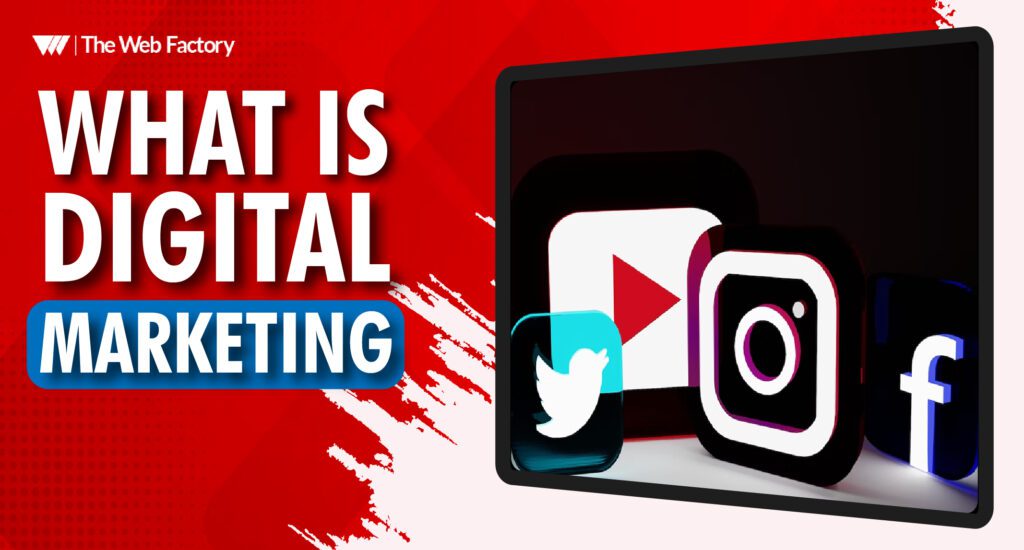Do you ever open the Internet or social media, and some products start appearing on your feed? Do you know the process of them appearing in front of you like that? That’s the magic of digital marketing.
Businesses use Digital Marketing to reach a wider range of audiences and sell their products through online mediums. Sounds convenient, doesn’t it?
Have you launched a business online, or do you plan to do so? You might have stumbled upon the right guide! We’ll go through the insights of Digital Marketing together. So, buckle up, and let’s dig in!
Digital Marketing
All marketing operations on the Internet are referred to as digital marketing, often known as online marketing. Businesses and companies use digital mediums such as search engines, social media, email, and other websites to engage with present and potential consumers. Communication through the means of text or multimedia is also included.
Digital marketing targets a certain portion of the consumers/customers. It includes search result advertisements, sponsored posts, email ads — anything that relates marketing with customers’ feedback or two-way communication between the firm and the customer.
Through digital marketing, you can discover individuals interested in your product, communicate with them, and establish confidence in your brand.
Contrary to traditional marketing, Digital marketing is a static, dynamic, ever-changing process frequently referred to as “one-way” communication. Customers cannot connect with a company through a billboard or print advertisement but rather digitally. However, digital marketing allows for two-way contact between a company and its current or potential customers.
Following are the channels or means through which you may have a two-way conversation with your customers;
- Your website
- Social Media platforms (Facebook, Instagram, TikTok, youtube, etc.)
- Video content
- Reviews
- Written content
Why is Digital Marketing Important?
You’ll be able to attract more potential clients digitally than you can achieve locally. You may reach global recognition with digital marketing tactics that are cost-effective, scalable, and quantifiable.
Digital marketing can help you have a wider reach that might go global and have quantifiable results – you can check and keep track of the progress of your business. Furthermore, digital marketing provides an easier and quicker conversion rate, and you can connect with your customer easily via online means.
It is less expensive than traditional advertising and allows you to track results daily and pivot as needed.
9 Types of Digital Marketing
There are various ways you can use digitally market your business. The most important ones are;
- Website Marketing
- Search Engine Optimization
- Search Engine Marketing
- Pay Per Click (PPC) Advertising
- Content Marketing
- Social Media Marketing
- Email Marketing
- Inbound/Outbound Marketing
- Affiliate Marketing
-
Website Marketing
A website may be a very effective marketing tool. It is a digital marketing channel representing your company on the Internet and is one of the most fundamental ways to increase traffic and revenue.
As part of your entire digital marketing campaign, it is one of the internet marketing platforms you may employ. A website marketing campaign’s main purpose is to increase the number of visitors to your website and sell your products or services digitally.
-
Search Engine Optimization
This is the process of improving the amount of organic traffic to your website by optimizing it to “rank” higher in search engine results pages. Websites, blogs, and infographics are among the mediums that profit from SEO.
Search Engine Optimization is a marketing tactic digital marketers use to draw more traffic to your website through good rankings on the search engine.
Digital marketers may apply three different kinds of SEO practices that include;
- On-page SEO — This type of SEO concentrates on all of your website’s material available “on the page.”
- Off-page SEO — When it comes to optimizing your website, this kind of SEO concentrates on everything that happens “off the page,” which means drawing traffic to your website from other online mediums.
- Technical SEO — Technical SEO is optimizing your website on the backend. This kind of SEO concentrates on your website’s backend and the coding of your page to get a higher ranking on the SERPs.
These SEO practices can boost the ranking of your website on the search engine and bring more audience and traffic to your website, which can result in a higher conversion rate of potential customers.
-
Search Engine Marketing
Marketing a business or a company through paid ads that display on search engine results pages (or SERPs) is known as search engine marketing (SEM). Advertisers put ads on keywords that the users of search engines could type in when looking for a particular item or service, giving them the chance to display their adverts and the results for such queries.
The greatest potential of search engine marketing is that it enables marketers to place their advertisements in front of interested clients who are willing to buy when they see the ads.
-
Pay-Per-Click (PPC) Advertising
In digital marketing, pay-per-click is a prevalent advertising technique. Advertisers may place advertisements on search engines, social media sites, and third-party websites and pay a charge every time the ad is clicked.
“Pay Per Click” is a self-explanatory term that means you’d be paying a particular amount every time a customer or prospect “clicks” on your website.
Pay-per-click (PPC) ads can be set up on Google, Bing, Linkedin, Twitter, Pinterest, and Facebook to show advertisements to those looking for phrases related to your products or services. Users can be segmented in PPC ads based on their demographic features (age, gender, etc.) and their specific interests or geography.
-
Content Marketing
SEO is a very significant factor in content marketing. Content marketing is a strategy to deliver appropriate and useful content to a target audience.
Content marketing aims to employ content to reach out to potential customers. Generally, content is uploaded on a website and then marketed using social networking sites, email marketing, SEO, or even PPC advertising. Blogs, ebooks, e-learning, visuals, infographics, podcasts, and webinars are examples of content marketing tools.
Content marketing is important, as evidenced by the following statistics:
- Consumers want businesses to create interesting and useful content experiences, according to 84% of respondents.
- Companies with at least 5,000 workers create material daily in 62% of cases.
- 92% of marketers agree that content is vital for their firm.
-
Social Media Marketing
Social media marketing may increase traffic and brand exposure by actively involving people in online discussions. Since social media marketing entails active audience interaction, it has grown in popularity to attract the attention of potential customer markets.
It’s the most popular content platform for B2C marketers, and it’s also getting momentum in the B2B world. Last year, 61% of B2B content marketers boosted their social media usage, according to the Content Marketing Institute.
Following are the social media platforms you can utilize to market your business socially;
Even if you don’t pay for it, social media marketing is one of the most effective digital marketing techniques you can use.
-
Email Marketing
Sending promotional emails to a network of clients who have provided their explicit consent to receive email messages from you is referred to as email marketing. You may use email marketing to enlighten your contacts, increase sales, and establish a community around your business.
Email marketing is an approach for businesses to communicate with their customers. Email is frequently used for advertising information, offers, and events and for sending customers to a company’s website.
-
Inbound / Outbound Marketing
Inbound marketing strategy expands your business by creating long-term, meaningful relationships with your prospects. It appreciates and empowers these individuals to achieve their objectives and desired results in your relationship with you.
Inbound marketing attracts your customers, converts them, and encourages them to tell others about your services.
Outbound marketing, on the contrary, is a type of marketing that involves sending messages to potential consumers. Trade exhibitions, lecture series, and cold phoning are examples of outbound marketing activities. It is costly, and the return on investment (ROI) is substantially lower than inbound marketing.
-
Affiliate Marketing
Affiliate marketing is one of the earliest known types of advertising, and the Internet has given this old staple a fresh start. Influencers or affiliates that use affiliate marketing to promote other people’s products earn a commission every time a lead is generated through their promotional posts.
Affiliate marketing uses a revenue-sharing model. For example, if you are an affiliate, you will be entitled to get a commission every time someone buys the products or services. You pay the affiliate for each sale they assist you in making if you’re the one owning the business.
Digital Marketing Strategy
A digital marketing strategy is an in-depth plan that outlines how you’ll use various digital marketing channels to meet your business objectives. When creating a digital marketing campaign, think about which channels to employ, how many resources to allocate to each channel, and what outcomes to expect.
A digital marketing plan optimizes the influence of managed, paid, and earned media on the internet. These marketing tactics include a variety of mediums, including website content and blogs, internet advertising, reviews, and testimonials.
A digital marketing strategy varies depending on the type of company and industry. You can make this strategy yourself or hire digital marketing services from an agency to help you achieve your target audience.
7Ds Of Digital Marketing
Usually, digital marketers follow the 7Ds pattern to boost their traffic. Keeping those 7Ds into consideration might enhance the reach of your website;
- Digital Goals — Identify your business goals. Considering your digital marketing strategy, identify the objectives you want to achieve through digital marketing.
- Digital Audience — Understanding the traits and preferences of online audiences to offer more relevant information and experiences to various target segments to increase interactions.
- Digital Devices — Different digital devices such as smartphones, tablets, desktop computers, TVs, gaming devices, smart assistants, and other connected gadgets are used by our audiences to engage with companies.
- Digital Media — Advertising, email and message, search engines, and social networks are all examples of paid, owned, and earned media communication networks for engaging potential audiences.
- Digital Platforms — Different platforms help you achieve your digital goals online, such as your website, Facebook, Google, Instagram, TikTok, etc.
- Digital Data — In most countries, companies must now preserve the information they acquire about their customer profiles and interactions with enterprises, which is now required by law.
- Digital Technology — the marketing technology used by a business can help the enterprise create a two-way customer-business interaction through websites, emails, and mobile apps.
Final Word
Digital Marketing is referred to as digital marketing. It is not one technique that works but a collection of tactics you may apply based on your goals. Since not all strategies work for all companies, it’s critical to establish a digital marketing strategy that outlines how you’ll use each one.
A good digital marketing campaign must include specific demands and objectives. One of the key considerations of every company’s marketing plan should be its digital marketing strategy.
There can never be a better way to remain in touch with your consumers, and nothing comes close to the personalization that digital information can bring. You will be able to achieve your company’s developmental objectives the more you embrace the potential of digital marketing.











